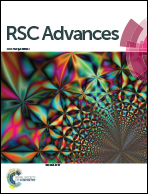Branched ultra-fine nickel oxide/manganese dioxide core–shell nanosheet arrays for electrochemical capacitors
Abstract
We demonstrate the fabrication of ultra-fine hierarchical NiO@MnO2 core–shell nanosheet arrays on carbon fiber paper via a facile and two-step hydrothermal method as the electrode for supercapacitors. Owing to the unique hierarchical core–shell heterostructured nanosheet array configuration and synergetic contribution from the NiO core and MnO2 shell, the as-prepared hybrid nanosheet arrays exhibited a high specific capacitance of 494.8 F g−1 and good rate capability, which are better than those of the obtained individual component of the NiO nanosheets. More importantly, the asymmetric supercapacitor, composed of NiO@MnO2 core–shell nanosheet arrays as the positive electrode and activated carbon as the negative electrode delivers a specific capacitance of 86.3 F g−1 and reaches up to an energy density of 30.6 W h kg−1 and power density of 400 W kg−1. The improved performance of the NiO@MnO2 core–shell nanosheet arrays demonstrates that rational design of electrode structure is an effective way to fabricate a high-performance electrode for supercapacitors.


 Please wait while we load your content...
Please wait while we load your content...